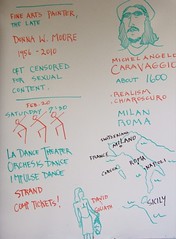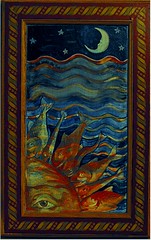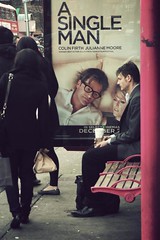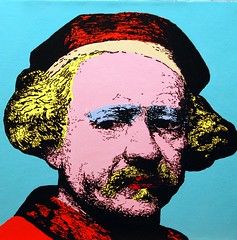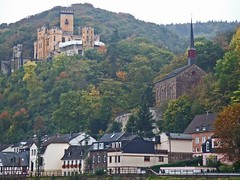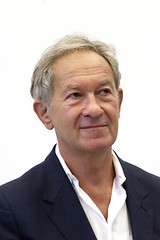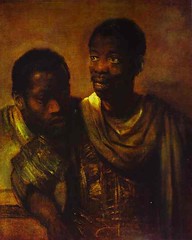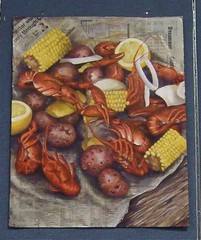Presentations on Michelangelo di Lodovico Buonarroti Simon ( 1475 – 1564), commonly known as Michelangelo.
He was an Italian Renaissance painter, sculptor, architect, poet, and engineer. His versatility in the disciplines he took up was of such a high order that he is often considered the archetypal Renaissance man, along with his rival and fellow Italian Leonardo da Vinci.
Groups will produce presentations based on
- 10 images (or more)
- bulleted and brief info
- documentation on each image
- detailed paragraph of comparison (to Leonardo, Caravaggio, etc) in final slide; use examples.
- 15 pts.
- presentations will be delivered on Fri in the PAC - to related classes.
Topics -
1. Early life in Tuscany
2. Early adulthood: Florence and the Medici
3. the Pieta, Laocoon, Bacchus and Roma
4. Il Davido: the heroic statue of David
5. the tomb of Pope Julius II
6. the ceiling of the Sistine Chapel
7. funerary chapel in the basilica of San Lorenzo
8. the fresco of The Last Judgment on the altar wall of the Sistine Chapel
9. censorship and Michelangelo
10. architectural projects: St. Peter's, Palazzo Farnese, San Giovanni dei Fiorentini, the Sforza Chapel (Capella Sforza) in the Basilica di Santa Maria Maggiore, Porta Pia and Santa Maria degli Angeli
11. comparison of Michelangelo and Leonardo
Tuesday, February 23, 2010
Sunday, February 21, 2010
Friday, February 19, 2010
Caravaggio : " enigmatic, fascinating, rebellious and dangerous"
Michelangelo Merisi da Caravaggio, (1571 – 1610) was an Italian artist active in Rome, Naples, Malta and Sicily between 1593 and 1610.
He was the first great representative of the Baroque school of painting, noted for his intensely emotional canvases and dramatic use of lighting, says Wikipedia.[1]
Even in his own lifetime Caravaggio was considered enigmatic, fascinating, rebellious and dangerous.
He burst upon the Rome art scene in 1600, and thereafter never lacked for commissions or patrons, yet he handled his success atrociously. An early published notice on him, dating from 1604 and describing his lifestyle three years previously, tells how "after a fortnight's work he will swagger about for a month or two with a sword at his side and a servant following him, from one ball-court to the next, ever ready to engage in a fight or an argument, so that it is most awkward to get along with him."[2]
In 1606 he killed a young man in a brawl and fled from Rome with a price on his head. In Malta in 1608 he was involved in another brawl, and yet another in Naples in 1609, possibly a deliberate attempt on his life by unidentified enemies. By the next year, after a relatively brief career, he was dead.
Huge new churches and palazzi were being built in Rome in the decades of the late 16th and early 17th Centuries, and paintings were needed to fill them. The Counter-Reformation Church searched for authentic religious art with which to counter the threat of Protestantism, and for this task the artificial conventions of Mannerism, which had ruled art for almost a century, no longer seemed adequate.
Caravaggio's novelty was a radical naturalism which combined close physical observation with a dramatic, even theatrical, use of the shift from light to dark with little intermediate value.
Famous and extremely influential while he lived, Caravaggio was almost entirely forgotten in the centuries after his death, and it was only in the 20th century that his importance to the development of Western art was rediscovered.
He was the first great representative of the Baroque school of painting, noted for his intensely emotional canvases and dramatic use of lighting, says Wikipedia.[1]
Even in his own lifetime Caravaggio was considered enigmatic, fascinating, rebellious and dangerous.
He burst upon the Rome art scene in 1600, and thereafter never lacked for commissions or patrons, yet he handled his success atrociously. An early published notice on him, dating from 1604 and describing his lifestyle three years previously, tells how "after a fortnight's work he will swagger about for a month or two with a sword at his side and a servant following him, from one ball-court to the next, ever ready to engage in a fight or an argument, so that it is most awkward to get along with him."[2]
In 1606 he killed a young man in a brawl and fled from Rome with a price on his head. In Malta in 1608 he was involved in another brawl, and yet another in Naples in 1609, possibly a deliberate attempt on his life by unidentified enemies. By the next year, after a relatively brief career, he was dead.
Huge new churches and palazzi were being built in Rome in the decades of the late 16th and early 17th Centuries, and paintings were needed to fill them. The Counter-Reformation Church searched for authentic religious art with which to counter the threat of Protestantism, and for this task the artificial conventions of Mannerism, which had ruled art for almost a century, no longer seemed adequate.
Caravaggio's novelty was a radical naturalism which combined close physical observation with a dramatic, even theatrical, use of the shift from light to dark with little intermediate value.
Famous and extremely influential while he lived, Caravaggio was almost entirely forgotten in the centuries after his death, and it was only in the 20th century that his importance to the development of Western art was rediscovered.
Thursday, February 18, 2010
Rembrandt lighting project / 5 portraits plus commentary, 15 pts
Project shall include no less than 5 portraits. Of those, some 2.5 should be converted to black / white.
Imitate Rembrandt in various ways:
- hats
- glasses (no more than 2, unless you're full-time like me).
- coats, scarves, jewelry
100-word (or more) discussion of the progress and / or outcome of your project. What you did; what you learned. Offer description and insight. That would be in image 6.
Share it w me in a Google Doc presentation. 15 pts.
‘Rembrandt’ or ‘chiaroscuro’ lighting accentuates the focal point of the composition by bathing it in light and surrounding the focal point by darker recesses, says David Bennett.
The Italian word ‘chiaroscuro’ means light and dark, and the alternative name of ‘Rembrandt’ lighting comes from the fact that he created that lighting effect in a lot of his paintings and may be the finest artist to have used the technique.
The contrast between light and dark areas also accentuates the three-dimensional appearance of the subject.
This is traditional, timeless, lighting, says Belle Gerard. Your main light is about 45 degrees to the right of center - and above your subject.
The key is to have the shadow created by the nose connect with the shadow on the far side of the face - creating a triangular highlight on the subject’s cheek.
By varying the amount of fill, and the harshness of the light, you can have crazy dramatic light or classic portrait lighting.
Imitate Rembrandt in various ways:
- hats
- glasses (no more than 2, unless you're full-time like me).
- coats, scarves, jewelry
100-word (or more) discussion of the progress and / or outcome of your project. What you did; what you learned. Offer description and insight. That would be in image 6.
Share it w me in a Google Doc presentation. 15 pts.
‘Rembrandt’ or ‘chiaroscuro’ lighting accentuates the focal point of the composition by bathing it in light and surrounding the focal point by darker recesses, says David Bennett.
The Italian word ‘chiaroscuro’ means light and dark, and the alternative name of ‘Rembrandt’ lighting comes from the fact that he created that lighting effect in a lot of his paintings and may be the finest artist to have used the technique.
The contrast between light and dark areas also accentuates the three-dimensional appearance of the subject.
This is traditional, timeless, lighting, says Belle Gerard. Your main light is about 45 degrees to the right of center - and above your subject.
The key is to have the shadow created by the nose connect with the shadow on the far side of the face - creating a triangular highlight on the subject’s cheek.
By varying the amount of fill, and the harshness of the light, you can have crazy dramatic light or classic portrait lighting.
Tuesday, February 16, 2010
Ash Wednesday's Mardi Gras Quiz

Front page of the Shreveport Times: Jennette Ginsberg, Blanc et Noir in the Krewe of Highland Parade, Shreveport / photo Henrietta Wildsmith
Originally uploaded by trudeau
2. translate: bons
3. translate: rouler
4. translate: laissez
5. translate: temps
6. translate: gras
7. Louisiana's carnival season does not begin on a) Twelfth Night b) Epiphany c) Jan 6 d) Ash Wed.
8. Dionysian celebration: a) Greek b) Roman c) Persian.
9. Lupercalia: a) Greek b) Roman c) Persian.
10. Translate a) Carne: ___ b) vale: ___
11. Translate: "Lent."
12. First 5 nations, European ones, associated with carnival.
13. First historic era in which Carnevale is written about: a) Medieval b) Renaissance c) Elizabethan.
14. Examples (2) of riotous behavior during ancient Carnival history.
15. Translate: Shrove Tuesday.
16. Female krewe in New Orleans.
17. Why were parades instituted in New Orleans about 1857?
18. Two European cities that establish the early carnival customs.
19. First krewe of Louisiana.
20. Alabama location with considerable influence on New Orleans (NO) Carnival?
21. 2 differences between Alabama and NO celebrations.
22. Primary public activity that was considered a basic pleasure of the pioneer days?
23. The location of Congo Square in New Orleans?
24. Activities by slaves in Congo Square? Frequency?
25. The second oldest krewe?
26. 3 customs established by Rex.
27. Etymology of “Rex.”
28. Make a timeline of Comus, Rex and Zulu.
29. Cheap coin “throw”?
30. Mardi Gras has neighborhood clubs that call themselves "gangs."
Are they a) MG Indians b) Drug organizations c) Brass bands.
31. What organization is brought to mind by the phrase “two-way pocky way!”?
32. Blanc et Noir Marching Society hires what sort of band for the Krewe of Highland parade?
33. When did jazz music begin?
34. In what kinds of bands did jazz begin?
35. Explain the meaning of the French term "boeuf gras."
36. What are the flambeaux?
37. A famous Louisianian signed his letters, “Red beans and ricely yours,” His name and nickname?
38. What is one of the themes of New Orleans costuming?
39. How long did French immigrants live in Nova Scotia before a journey that would take them to Louisiana?
40. Why are they called Acadians, or Cajuns?
41. What is the name for the Cajun Mardi Gras?
42. Another name for a Cajun house party?
43. What 2 types of music mingle in Zydeco?
44. What ethnic group created zydeco?
45. Make a small map featuring Europe, South America, Central America and North America. List nations in which we see a significant carnival celebration.
answers -
1. W Af: Senegal, Guinea, Liberia, etc etc
2. bons - good
3. rouler - to roll
4. laissez - to let
5. temps - times
6. gras - fat
7. 12th Night begins Carnival in La. aka Epiphany or Jan 6.
8. Dionysian - Greek revels
9. Lupercalia - Roman rituals
10. carne - meat / vale - goodbye Latin
11. Lent - Christian; 40 days fasting & abstinence
12. Original Carnival nations: Italy, Germany, France, Spain, Portugal.
13. Medieval times: first mention of Carnival.
14. Riotous: throwing bricks, desecrating churches.
15. Shrive: forgive your sins. See English custom.
16. Endymion is a female krewe in NO.
17. Parades helped the city move away from Fat Tuesday anarchy.
18. Carnival origins: Venice, Rome.
19. 1st NO krewe: Mystick Krewe of Comus.
20. Mobile, AL
21. Alabama: New Years celebration / Cowbellian de Rakin Society
NO: Fat Tuesday / Comus
22. Pioneers: dancing!
23. Congo Square: back of the city of NO.
24. Congo Square: dancing, singing every Sunday.
25. 2nd oldest: Rex.
26. Rex: doubloons, colors purple, green, gold, a holiday from school.
27. Rex: "king" Latin
28. a) Comus b) Rex c) Zulu
29. doubloon
30. MG Indians
31. MG Indians: "two way pocky way"
32. jazz
33. jazz originates in 1890's.
34. Jazz originates in brass bands.
35. Boeuf gras: Fat beef cow.
36. flambeaux: torches.
37. Louis Satchmo Armstrong: "Red beans ..."
38. Costuming: opposite of what you are.
39. Acadiennes: 100 years in Nova Scotia.
40. Acadians - people from a region called Acadia.
41. Courir de Mardi Gras: cajuns.
42. bals de Maison: house party.
43. Zydeco: blues plus French folk music.
44. Creoles created both zydeco as well as Cajun music.
45. map.
Wednesday, February 10, 2010
Fine arts: muses and the proto-Indo-Euro language
The 9 Muses (Ancient Greek; perhaps from the Proto-Indo-European root *men- "think"[2]) in Greek mythology, poetry, and literature are the goddesses or spirits who inspire the creation of literature and the arts.
Calliope / Epic poetry / Writing tablet
Clio / History / Scrolls
Erato / Lyric poetry / Cithara (an ancient Greek musical instrument in the lyre family)
Euterpe / Music / Aulos (an ancient Greek musical instrument)
Melpomene / Tragedy / Tragic mask
Polyhymnia / Choral poetry / Veil
Terpsichore / Dance / Lyre
Thalia / Comedy / Comic mask
Urania / Astronomy / Globe and compass
Famously in Louisiana these are 9 street names in historic New Orleans.
The archaic poet Sappho of Lesbos was given the compliment of being called "the tenth Muse" by Plato. The phrase has become a somewhat conventional compliment paid to female poets since.
Proto - first
Indo - refers to India and its Aryan invaders.
It is important to recognize the ancient flow of language (Sanskrit to Farsi to Greek and Latin) from India to Persia to Europe.
Music?
Warhol loved Top 40 such as Motown hits. Eventually he produced the Velvet Underground, a sort of folk-rock group.
Rembrandt lived during the Baroque era. Music by JS Bach would have been his milieu.
Calliope / Epic poetry / Writing tablet
Clio / History / Scrolls
Erato / Lyric poetry / Cithara (an ancient Greek musical instrument in the lyre family)
Euterpe / Music / Aulos (an ancient Greek musical instrument)
Melpomene / Tragedy / Tragic mask
Polyhymnia / Choral poetry / Veil
Terpsichore / Dance / Lyre
Thalia / Comedy / Comic mask
Urania / Astronomy / Globe and compass
Famously in Louisiana these are 9 street names in historic New Orleans.
The archaic poet Sappho of Lesbos was given the compliment of being called "the tenth Muse" by Plato. The phrase has become a somewhat conventional compliment paid to female poets since.
Proto - first
Indo - refers to India and its Aryan invaders.
It is important to recognize the ancient flow of language (Sanskrit to Farsi to Greek and Latin) from India to Persia to Europe.
Music?
Warhol loved Top 40 such as Motown hits. Eventually he produced the Velvet Underground, a sort of folk-rock group.
Rembrandt lived during the Baroque era. Music by JS Bach would have been his milieu.
Requiescat in pace, Donna W Moore, 1956 - 2010, Shreveport artist
This is a painting by the late Donna G Moore in which more is happening than meets the eye.
The wavingly cheery rays of the sun as he burns, somehow, under the sea are not what they seem in this painting.
For the rays are not radiant lines but fish. And those fish are eating the rim of the sun.
What?
The pre-Christian history of the fish symbol includes:
The fish symbol has been used for millennia worldwide as a religious symbol associated with the Pagan Great Mother Goddess. It is the outline of her vulva. The fish symbol was often drawn by overlapping two very thin crescent moons. One represented the crescent shortly before the new moon; the other shortly after, when the moon is just visible. The Moon is the heavenly body that has long been associated with the Goddess, just as the sun is a symbol of the God.
The link between the Goddess and fish was found in various areas of the ancient world, says religioustolerance.org:
- In China, Great Mother Kwan-yin is often portrayed in the shape of a fish.
- In India, the Goddess Kali was called the "fish-eyed one."
- In Egypt, Isis was called the Great Fish of the Abyss.
- In Greece the Greek word "delphos" meant both fish and womb. The word is derived from the location of the ancient Oracle at Delphi who worshipped the original fish goddess, Themis. The later fish Goddess, Aphrodite Salacia, was worshipped by her followers on her sacred day, Friday. They ate fish and engaged in orgies. From her name comes the English word "salacious" which means lustful or obscene. Also from her name comes the name of our fourth month, April. In later centuries, the Christian church adsorbed this tradition by requiring the faithful to eat fish on Friday - a tradition that was only recently abandoned.
- In ancient Rome Friday is called "dies veneris" or Day of Venus, the Pagan Goddess of Love.
- Throughout the Mediterranean, mystery religions used fish, wine and bread for their sacramental meal.
- In Scandinavia, the Great Goddess was named Freya; fish were eaten in her honor. The 6th day of the week was named "Friday" after her.
- In the Middle East, the Great Goddess of Ephesus was portrayed as a woman with a fish amulet over her genitals.
Thus the Moore painting is using classic feminist symbols to turn the world on its head. She wants to say, symbolically, that there might be a day when the moon and the fish take down the sun.
The wavingly cheery rays of the sun as he burns, somehow, under the sea are not what they seem in this painting.
For the rays are not radiant lines but fish. And those fish are eating the rim of the sun.
What?
The pre-Christian history of the fish symbol includes:
The fish symbol has been used for millennia worldwide as a religious symbol associated with the Pagan Great Mother Goddess. It is the outline of her vulva. The fish symbol was often drawn by overlapping two very thin crescent moons. One represented the crescent shortly before the new moon; the other shortly after, when the moon is just visible. The Moon is the heavenly body that has long been associated with the Goddess, just as the sun is a symbol of the God.
The link between the Goddess and fish was found in various areas of the ancient world, says religioustolerance.org:
- In China, Great Mother Kwan-yin is often portrayed in the shape of a fish.
- In India, the Goddess Kali was called the "fish-eyed one."
- In Egypt, Isis was called the Great Fish of the Abyss.
- In Greece the Greek word "delphos" meant both fish and womb. The word is derived from the location of the ancient Oracle at Delphi who worshipped the original fish goddess, Themis. The later fish Goddess, Aphrodite Salacia, was worshipped by her followers on her sacred day, Friday. They ate fish and engaged in orgies. From her name comes the English word "salacious" which means lustful or obscene. Also from her name comes the name of our fourth month, April. In later centuries, the Christian church adsorbed this tradition by requiring the faithful to eat fish on Friday - a tradition that was only recently abandoned.
- In ancient Rome Friday is called "dies veneris" or Day of Venus, the Pagan Goddess of Love.
- Throughout the Mediterranean, mystery religions used fish, wine and bread for their sacramental meal.
- In Scandinavia, the Great Goddess was named Freya; fish were eaten in her honor. The 6th day of the week was named "Friday" after her.
- In the Middle East, the Great Goddess of Ephesus was portrayed as a woman with a fish amulet over her genitals.
Thus the Moore painting is using classic feminist symbols to turn the world on its head. She wants to say, symbolically, that there might be a day when the moon and the fish take down the sun.
Monday, February 8, 2010
Colin Firth in A Single man, story by Tom Ford and Christopher Isherwood, at RFC through Feb 18
Highly recommended: A Single Man, a day in the life of a gay English professor in California, 1962. It is a story of desire and death with superb detail.
99 mins.
See it at RFC.
Read background and reviews.
99 mins.
See it at RFC.
Read background and reviews.
Rembrandt Warhol: Distant brothers
Rembrandt and Warhol, Distant Brothers.
Presentation project.
In lab: No extended chatting; no sustained off-topic excursions,
please.
Instructions are on class web site and were discussed last week.
Students will have 2 days in the lab to put work on GoogleDocs.
Presentations will be scored at 15 pts; emphasis on insight shown in essay at end of project. Please see below for more detail.
To be delivered on Wed, Th, and Fri.
The artist who created this illustration noted: Acrylic painting 16 by 16. done for an exhibition titled "Homage.." I chose to homage Rembrandt and Warhol. Rembrandt because he was a master of the self portrait and Warhol because he said, " Everything I do is a self portrait."
Presentation project.
In lab: No extended chatting; no sustained off-topic excursions,
please.
Instructions are on class web site and were discussed last week.
Students will have 2 days in the lab to put work on GoogleDocs.
Presentations will be scored at 15 pts; emphasis on insight shown in essay at end of project. Please see below for more detail.
To be delivered on Wed, Th, and Fri.
The artist who created this illustration noted: Acrylic painting 16 by 16. done for an exhibition titled "Homage.." I chose to homage Rembrandt and Warhol. Rembrandt because he was a master of the self portrait and Warhol because he said, " Everything I do is a self portrait."
Friday, February 5, 2010
Fine Arts Magnet self-portrait project; 15 pts, due Fri, Feb 12
With our inspiration coming from Rembrandt, Fine Arts students dive into a series of self-portraits.
Notice the chiaroscuro achieved by Tyler in this shot. Everyone must demonstrate the use of side light.
No less than 5 portraits. Of those, some 2.5 should be converted to black / white.
Imitate Rembrandt in various ways:
- hats
- glasses (no more than 2, unless you're full-time like me).
- coats, scarves, jewelry
100-word (or more) discussion of the progress and / or outcome of your project. What you did; what you learned. Offer description and insight. That would be in image 6.
Google Doc presentation. 15 pts.
Deadline Fri, Feb 12. Presentations in class.
Notice the chiaroscuro achieved by Tyler in this shot. Everyone must demonstrate the use of side light.
No less than 5 portraits. Of those, some 2.5 should be converted to black / white.
Imitate Rembrandt in various ways:
- hats
- glasses (no more than 2, unless you're full-time like me).
- coats, scarves, jewelry
100-word (or more) discussion of the progress and / or outcome of your project. What you did; what you learned. Offer description and insight. That would be in image 6.
Google Doc presentation. 15 pts.
Deadline Fri, Feb 12. Presentations in class.
Rembrandt and Warhol project
Using 10 images, explore the consonances and confluences that connect or distance Rembrandt and Warhol.
On each image, add 2 to 4 items of info. Sources at bottom of each image.
Eleventh slide: a brief essay that includes details and offers insight into the ways in which they were similar.
On each image, add 2 to 4 items of info. Sources at bottom of each image.
Eleventh slide: a brief essay that includes details and offers insight into the ways in which they were similar.
Review of A History of Painting
Review of A History of Painting
1. The pigments of the Paleolithic paintings of Lascaux are derived from: a) vegetation b) minerals c) incisions in the stone d) fire.
2. In the Nave of Lascaux is a figure whose limbs show an unusually early grasp of a) length b) equines c) aurochs d) perspective.
3. Bos primigenius was not an a) auroch b) urus c) bovine d) hematite.
4. Finds of Paleolithic cave art range from Russia to Portugal. T / F
5. The face of the Venus of Willendorf resembles that of a fertility ritual or of a doll.
T / F
6. Sister Wendy is a particularly appropriate "contemplative hermit." T / F
7. The eye of Horus might also be termed the eye of Ra. T / F
8. The Book of Kells is a masterwork of what is termed Insular illumination. That term means a) vivid illustrations b) golden decorations c) island art d) swirling motifs.
9. The Book of Kells represents the early Northern European culture called the
a) Irish b) Christian c) Celts d) Latins.
10. In the illuminated book Les Tres Riches Heures du Duc de Berry the "hours" refers to a) prayer b) his royal life c) seasons of the year d) honesty.
11. Holden Caulfield: a) Dickens b) Shakespeare c) Proust d) Salinger.
12. Chiaroscuro: a) shadow and light b) impasto c) faux marbre d) trompe l'oeil.
13. What ethnic enclave is implied by Rembrandt's address on Jodenbreestraat?
a) merchants b) Dutch Protestants c) Jews d) nouveau riche.
14. The Dutch empire included Caribbean islands. T / F
15. The Rhine flows from Switzerland to a) Amsterdam b) Koln c) Nord Zee
d) English Channel.
1. The pigments of the Paleolithic paintings of Lascaux are derived from: a) vegetation b) minerals c) incisions in the stone d) fire.
2. In the Nave of Lascaux is a figure whose limbs show an unusually early grasp of a) length b) equines c) aurochs d) perspective.
3. Bos primigenius was not an a) auroch b) urus c) bovine d) hematite.
4. Finds of Paleolithic cave art range from Russia to Portugal. T / F
5. The face of the Venus of Willendorf resembles that of a fertility ritual or of a doll.
T / F
6. Sister Wendy is a particularly appropriate "contemplative hermit." T / F
7. The eye of Horus might also be termed the eye of Ra. T / F
8. The Book of Kells is a masterwork of what is termed Insular illumination. That term means a) vivid illustrations b) golden decorations c) island art d) swirling motifs.
9. The Book of Kells represents the early Northern European culture called the
a) Irish b) Christian c) Celts d) Latins.
10. In the illuminated book Les Tres Riches Heures du Duc de Berry the "hours" refers to a) prayer b) his royal life c) seasons of the year d) honesty.
11. Holden Caulfield: a) Dickens b) Shakespeare c) Proust d) Salinger.
12. Chiaroscuro: a) shadow and light b) impasto c) faux marbre d) trompe l'oeil.
13. What ethnic enclave is implied by Rembrandt's address on Jodenbreestraat?
a) merchants b) Dutch Protestants c) Jews d) nouveau riche.
14. The Dutch empire included Caribbean islands. T / F
15. The Rhine flows from Switzerland to a) Amsterdam b) Koln c) Nord Zee
d) English Channel.
Thursday, February 4, 2010
The Romantic Rhine: Stolzenfels Castle
Rembrandt: his last name, van Rijn, means "on the Rhine"
The Rhine -
German: Rhein;
Dutch: Rijn;
French: Rhin;
Romansh: Rain;
Italian: Reno;
Latin: Rhenus
West Frisian Ryn -
is one of the longest and most important rivers in Europe, at 820 mi.
The name of the Rhine derives from Gaulish Renos, and ultimately from the Proto-Indo-European root *reie- ("to move, flow, run"), which is also the root of words like river and run.[2] The Reno River in Italy shares the same etymology. The spelling with -h- seems to be borrowed from the Greek form of the name, Rhenos,[2] seen also in rheos, stream, and rhein, to flow.
The Rhine and the Danube formed most of the northern inland frontier of the Roman Empire and, since those days, the Rhine has been a vital, navigable waterway, and carried trade and goods deep inland.
The many castles and prehistoric fortifications along the Rhine testify to its importance as a waterway. River traffic could be stopped at these locations, usually for the purpose of collecting tolls, by the state that controlled that portion of the river.
The most notable wines from the Rhine valley: Riesling - fragrant dry or sweet white wine from the Rhine valley or a similar wine from California, and liebfraumilch - a sweetened Rhenish wine (especially one from Hesse in western Germany).
Due to the relief, the Rhine flows from Switzerland north to the Netherlands. The mouth of the Rhine is at Rotterdam.
Cities through which the Rhine flows:
Basel, Strasbourg, Mannheim, Wiesbaden, Mainz, Koblenz, Bonn, Cologne, Düsseldorf, Utrecht (Kromme Rijn) and Rotterdam (Nieuwe Maas).
The Rhine -
German: Rhein;
Dutch: Rijn;
French: Rhin;
Romansh: Rain;
Italian: Reno;
Latin: Rhenus
West Frisian Ryn -
is one of the longest and most important rivers in Europe, at 820 mi.
The name of the Rhine derives from Gaulish Renos, and ultimately from the Proto-Indo-European root *reie- ("to move, flow, run"), which is also the root of words like river and run.[2] The Reno River in Italy shares the same etymology. The spelling with -h- seems to be borrowed from the Greek form of the name, Rhenos,[2] seen also in rheos, stream, and rhein, to flow.
The Rhine and the Danube formed most of the northern inland frontier of the Roman Empire and, since those days, the Rhine has been a vital, navigable waterway, and carried trade and goods deep inland.
The many castles and prehistoric fortifications along the Rhine testify to its importance as a waterway. River traffic could be stopped at these locations, usually for the purpose of collecting tolls, by the state that controlled that portion of the river.
The most notable wines from the Rhine valley: Riesling - fragrant dry or sweet white wine from the Rhine valley or a similar wine from California, and liebfraumilch - a sweetened Rhenish wine (especially one from Hesse in western Germany).
Due to the relief, the Rhine flows from Switzerland north to the Netherlands. The mouth of the Rhine is at Rotterdam.
Cities through which the Rhine flows:
Basel, Strasbourg, Mannheim, Wiesbaden, Mainz, Koblenz, Bonn, Cologne, Düsseldorf, Utrecht (Kromme Rijn) and Rotterdam (Nieuwe Maas).
Wednesday, February 3, 2010
Februar - février - February - febbraio
February was named after the Latin term februum, which means purification, via the purification ritual Februa held on February 15 in the old Roman calendar, says Wikipedia.
January and February were the last two months to be added to the Roman calendar, since the Romans originally considered winter a monthless period. They were added by Numa Pompilius about 700 BCE.
The illustration is from the The Très Riches Heures du Duc de Berry (The Very Rich Hours of the Duke of Berry). It is a richly decorated Book of Hours (containing prayers to be said by the lay faithful at each of the canonical hours of the day) commissioned by Jean, Duc de Berry around 1410, says Wikipedia.
It is probably the most important illuminated manuscript of the 15th century, "le roi des manuscrits enluminés" ("the king of illuminated manuscripts"). The Très Riches Heures consists of 416 pages, including 131 with large miniatures and many more with border decorations or historiated initials, that are among the high points of International Gothic painting in spite of their small size.
January and February were the last two months to be added to the Roman calendar, since the Romans originally considered winter a monthless period. They were added by Numa Pompilius about 700 BCE.
The illustration is from the The Très Riches Heures du Duc de Berry (The Very Rich Hours of the Duke of Berry). It is a richly decorated Book of Hours (containing prayers to be said by the lay faithful at each of the canonical hours of the day) commissioned by Jean, Duc de Berry around 1410, says Wikipedia.
It is probably the most important illuminated manuscript of the 15th century, "le roi des manuscrits enluminés" ("the king of illuminated manuscripts"). The Très Riches Heures consists of 416 pages, including 131 with large miniatures and many more with border decorations or historiated initials, that are among the high points of International Gothic painting in spite of their small size.
Tuesday, February 2, 2010
British art historian Simon Schama
Simon Michael Schama, CBE (born in London 13 February 1945) is a British historian and art historian, says Wikipedia. He is a University Professor at Columbia University.[1]
His many works on history and art include The Embarrassment of Riches, Landscape and Memory, Dead Certainties, Rembrandt's Eyes,[2] and his history of the French Revolution, Citizens.[1]
He is best known for writing and hosting the 15-part BBC documentary series A History of Britain. He is an art and cultural critic for The New Yorker.[1]
His many works on history and art include The Embarrassment of Riches, Landscape and Memory, Dead Certainties, Rembrandt's Eyes,[2] and his history of the French Revolution, Citizens.[1]
He is best known for writing and hosting the 15-part BBC documentary series A History of Britain. He is an art and cultural critic for The New Yorker.[1]
Rembrandt and the painting technique called chiaroscuro
Chiaroscuro (Italian for light-dark) in art is contrast between light and dark, usually bold contrasts affecting a whole composition, says Wikipedia.
It is also more technically used by artists and art historians for the use of effects representing contrasts of light, not necessarily strong, to achieve a sense of volume in modeling three-dimensional objects such as the human body.
It is also more technically used by artists and art historians for the use of effects representing contrasts of light, not necessarily strong, to achieve a sense of volume in modeling three-dimensional objects such as the human body.
Rembrandt and the Netherlands
Notes on Rembrandt van Rijn
- 1606 - 1669
- dramatic lighting: chiaroscuro (Italian, "Light-dark")
- portraits
- realism
- etching / prints
- teacher of best Dutch artists
- late 1600's a Golden Age for Holland in trade and empire-building
- Amsterdam
- Nord Zee (North Sea)
- Netherlands (low lands)
* ship design
* trading, banking
* empire: Indonesia, South Africa, Caribbean islands (Curacao), New Amserdam.
* Holland's neighbors: Germany, France, Belgium, England.
* Royal Dutch petroleum
* Phillips Electronics (cassette)
* Heineken, Grolsch, Amstel beers
* Gouda cheese
* Dutch utopian spirit
- 1606 - 1669
- dramatic lighting: chiaroscuro (Italian, "Light-dark")
- portraits
- realism
- etching / prints
- teacher of best Dutch artists
- late 1600's a Golden Age for Holland in trade and empire-building
- Amsterdam
- Nord Zee (North Sea)
- Netherlands (low lands)
* ship design
* trading, banking
* empire: Indonesia, South Africa, Caribbean islands (Curacao), New Amserdam.
* Holland's neighbors: Germany, France, Belgium, England.
* Royal Dutch petroleum
* Phillips Electronics (cassette)
* Heineken, Grolsch, Amstel beers
* Gouda cheese
* Dutch utopian spirit
The Night Watch by Rembrandt van Rijn
Rembrandt Harmenszoon van Rijn (1606 – 1669) was a Dutch painter and etcher. He is generally considered one of the greatest painters and printmakers in European art history and the most important in Dutch history, says Wikipedia.[1] His contributions to art came in a period that historians call the Dutch Golden Age.
Having achieved youthful success as a portrait painter, his later years were marked by personal tragedy and financial hardship. Yet his etchings and paintings were popular throughout his lifetime, his reputation as an artist remained high,[2] and for twenty years he taught nearly every important Dutch painter.[3]
Rembrandt's greatest creative triumphs are exemplified especially in his portraits of his contemporaries, self-portraits and illustrations of scenes from the Bible. His self-portraits form a unique and intimate biography, in which the artist surveyed himself without vanity and with the utmost sincerity.[1]
Rembrandt[6] Harmenszoon van Rijn was born on July 15, 1606 in Leiden, the Netherlands. He was the ninth child.[7] His family was quite well-to-do; his father was a miller and his mother was a baker's daughter. As a boy he attended Latin school and was enrolled at the University of Leiden, although according to a contemporary he had a greater inclination towards painting; he was soon apprenticed to a Leiden history painter, Jacob van Swanenburgh, with whom he spent three years.
After a brief but important apprenticeship of six months with the famous painter Pieter Lastman in Amsterdam, Rembrandt opened a studio in Leiden in 1624 or 1625, which he shared with friend and colleague Jan Lievens. In 1627, Rembrandt began to accept students, among them Gerrit Dou.[8]
In 1629 Rembrandt was discovered by the statesman Constantijn Huygens, the father of Christiaan Huygens (a famous Dutch mathematician and physicist), who procured for Rembrandt important commissions from the court of The Hague. As a result of this connection, Prince Frederik Hendrik continued to purchase paintings from Rembrandt until 1646.[9]
At the end of 1631, Rembrandt moved to Amsterdam, then rapidly expanding as the new business capital of the Netherlands, and began to practice as a professional portraitist for the first time, with great success. He initially stayed with an art dealer, Hendrick van Uylenburg, and in 1634, married Hendrick's cousin, Saskia van Uylenburg.[10] Saskia came from a good family: her father had been lawyer and burgemeester (mayor) of Leeuwarden.
In 1635 Rembrandt and Saskia moved into their own house, renting in fashionable Nieuwe Doelenstraat. In 1639, they moved to a prominent house (now the Rembrandt House Museum) in the Jodenbreestraat in what was becoming the Jewish quarter; the mortgage to finance the 13,000 guilder purchase would be a primary cause for later financial difficulties.[12]
He should easily have been able to pay it off with his large income, but it appears his spending always kept pace with his income, and he may have made some unsuccessful investments.[13] It was there that Rembrandt frequently sought his Jewish neighbors to model for his Old Testament scenes.
During Saskia's illness, Geertje Dircx was hired as Titus' caretaker and nurse and probably also became Rembrandt's lover.
In the late 1640s Rembrandt began a relationship with the much younger Hendrickje Stoffels, who had initially been his maid. In 1654 they had a daughter, Cornelia, bringing Hendrickje a summons from the Reformed Church to answer the charge "that she had committed the acts of a whore with Rembrandt the painter".
Among the more prominent characteristics of his work are his use of chiaroscuro, the theatrical employment of light and shadow derived from Caravaggio, or, more likely, from the Dutch Caravaggisti, but adapted for very personal means.[33] Also notable are his dramatic and lively presentation of subjects, devoid of the rigid formality that his contemporaries often displayed, and a deeply felt compassion for mankind, irrespective of wealth and age.
His immediate family—his wife Saskia, his son Titus and his common-law wife Hendrickje—often figured prominently in his paintings, many of which had mythical, biblical or historical themes.
A parallel development may be seen in his skill as a printmaker. In the etchings of his maturity, particularly from the late 1640s onward, the freedom and breadth of his drawings and paintings found expression in the print medium as well. The works encompass a wide range of subject matter and technique, sometimes leaving large areas of white paper to suggest space, at other times employing complex webs of line to produce rich dark tones.[37]
Rembrandt painted The Militia Company of Captain Frans Banning Cocq between 1640 and 1642. This picture was called the Nachtwacht by the Dutch and the Night Watch by Sir Joshua Reynolds because, upon its discovery, the picture was so dimmed and defaced by time that it was almost indistinguishable and it looked quite like a night scene. After it was cleaned, it was discovered to represent broad day—a party of musketeers stepping from a gloomy courtyard into the blinding sunlight.
Having achieved youthful success as a portrait painter, his later years were marked by personal tragedy and financial hardship. Yet his etchings and paintings were popular throughout his lifetime, his reputation as an artist remained high,[2] and for twenty years he taught nearly every important Dutch painter.[3]
Rembrandt's greatest creative triumphs are exemplified especially in his portraits of his contemporaries, self-portraits and illustrations of scenes from the Bible. His self-portraits form a unique and intimate biography, in which the artist surveyed himself without vanity and with the utmost sincerity.[1]
Rembrandt[6] Harmenszoon van Rijn was born on July 15, 1606 in Leiden, the Netherlands. He was the ninth child.[7] His family was quite well-to-do; his father was a miller and his mother was a baker's daughter. As a boy he attended Latin school and was enrolled at the University of Leiden, although according to a contemporary he had a greater inclination towards painting; he was soon apprenticed to a Leiden history painter, Jacob van Swanenburgh, with whom he spent three years.
After a brief but important apprenticeship of six months with the famous painter Pieter Lastman in Amsterdam, Rembrandt opened a studio in Leiden in 1624 or 1625, which he shared with friend and colleague Jan Lievens. In 1627, Rembrandt began to accept students, among them Gerrit Dou.[8]
In 1629 Rembrandt was discovered by the statesman Constantijn Huygens, the father of Christiaan Huygens (a famous Dutch mathematician and physicist), who procured for Rembrandt important commissions from the court of The Hague. As a result of this connection, Prince Frederik Hendrik continued to purchase paintings from Rembrandt until 1646.[9]
At the end of 1631, Rembrandt moved to Amsterdam, then rapidly expanding as the new business capital of the Netherlands, and began to practice as a professional portraitist for the first time, with great success. He initially stayed with an art dealer, Hendrick van Uylenburg, and in 1634, married Hendrick's cousin, Saskia van Uylenburg.[10] Saskia came from a good family: her father had been lawyer and burgemeester (mayor) of Leeuwarden.
In 1635 Rembrandt and Saskia moved into their own house, renting in fashionable Nieuwe Doelenstraat. In 1639, they moved to a prominent house (now the Rembrandt House Museum) in the Jodenbreestraat in what was becoming the Jewish quarter; the mortgage to finance the 13,000 guilder purchase would be a primary cause for later financial difficulties.[12]
He should easily have been able to pay it off with his large income, but it appears his spending always kept pace with his income, and he may have made some unsuccessful investments.[13] It was there that Rembrandt frequently sought his Jewish neighbors to model for his Old Testament scenes.
During Saskia's illness, Geertje Dircx was hired as Titus' caretaker and nurse and probably also became Rembrandt's lover.
In the late 1640s Rembrandt began a relationship with the much younger Hendrickje Stoffels, who had initially been his maid. In 1654 they had a daughter, Cornelia, bringing Hendrickje a summons from the Reformed Church to answer the charge "that she had committed the acts of a whore with Rembrandt the painter".
Among the more prominent characteristics of his work are his use of chiaroscuro, the theatrical employment of light and shadow derived from Caravaggio, or, more likely, from the Dutch Caravaggisti, but adapted for very personal means.[33] Also notable are his dramatic and lively presentation of subjects, devoid of the rigid formality that his contemporaries often displayed, and a deeply felt compassion for mankind, irrespective of wealth and age.
His immediate family—his wife Saskia, his son Titus and his common-law wife Hendrickje—often figured prominently in his paintings, many of which had mythical, biblical or historical themes.
A parallel development may be seen in his skill as a printmaker. In the etchings of his maturity, particularly from the late 1640s onward, the freedom and breadth of his drawings and paintings found expression in the print medium as well. The works encompass a wide range of subject matter and technique, sometimes leaving large areas of white paper to suggest space, at other times employing complex webs of line to produce rich dark tones.[37]
Rembrandt painted The Militia Company of Captain Frans Banning Cocq between 1640 and 1642. This picture was called the Nachtwacht by the Dutch and the Night Watch by Sir Joshua Reynolds because, upon its discovery, the picture was so dimmed and defaced by time that it was almost indistinguishable and it looked quite like a night scene. After it was cleaned, it was discovered to represent broad day—a party of musketeers stepping from a gloomy courtyard into the blinding sunlight.
Monday, February 1, 2010
Fine Arts point sheet: Amadeus, Jan arts review, mult-choice test this week
Essays @ 15 pts each -
1) Review of Amadeus. Concentrate on following the guidelines on the web site.
2) January arts review. If you did not take in an event this weekend, check your event essay with me. You may write about an ethnic restaurant, an indie movie showing at RFC or review an exhibit at a gallery (Barnwell exhibit most highly recommended). Again, use the guidelines.
3) Multiple choice Quiz on the History of Painting series by Sister Wendy Beckett; notes on the class web site. Essentially a review quiz. Tentatively on Thurs. 15 pts.
1) Review of Amadeus. Concentrate on following the guidelines on the web site.
2) January arts review. If you did not take in an event this weekend, check your event essay with me. You may write about an ethnic restaurant, an indie movie showing at RFC or review an exhibit at a gallery (Barnwell exhibit most highly recommended). Again, use the guidelines.
3) Multiple choice Quiz on the History of Painting series by Sister Wendy Beckett; notes on the class web site. Essentially a review quiz. Tentatively on Thurs. 15 pts.
Subscribe to:
Posts (Atom)

